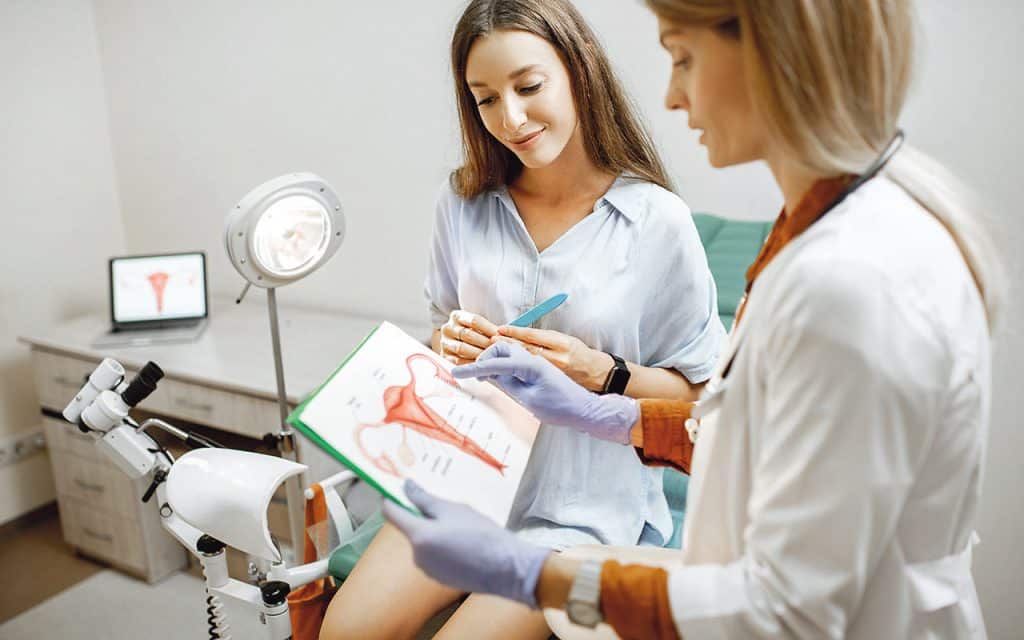
Menopause and Perimenopause are normal, physiological stages of female health.
Today I want to talk about what is abnormal so I will revisit some definitions.
Menopause is a retrospective diagnosis. This means that we can only say that a woman is menopausal if it has been 12 months since her last period.
The Perimenopause is the time between the first onset of any menopause symptoms and 12 months after a woman’s last period.
This lasts from four to eight years. In my experience as a Menopause Specialist this can span from age 45 to 55 years.
Menopause onset at age 40 to 45 is called Early Menopause. Menopause occurring under the age of 40 is regarded as premature and the medical term for this is Premature Ovarian Insufficiency or POI.
This occurs in one per cent or one in a 100 females, so it is not that rare. Menopause under the age of 30 years has a prevalence of 0.01 per cent or one in 1000 women.
Diagnosis
This first sign is usually a change to periods; they start to be further apart or skip a month.
While pregnancy needs to be ruled out, there are a few conditions that can cause changes to periods. These include problems with thyroid hormone, as well as prolactin, a hormone secreted by the hypothalamus in the brain. Dramatic weight loss causing a woman to be severely underweight can also switch off periods.
Eighty per cent of women with POI will have symptoms. Some 50 per cent will get vaginal symptoms of dryness and soreness and might complain that sex has become uncomfortable. Hot flushes may occur.
A woman who finds that her periods have become further apart, for a duration of more than three months, needs full investigation. This should include blood tests for full blood count, thyroid and prolactin hormones, as well as for female hormone follicle stimulating hormone, FSH.
While female hormone blood tests have no place in diagnosing the normal menopause process, an FSH level over 25-30iu on two occasions, separated by six weeks, in a woman under the age of 40 years, confirms the diagnosis of POI.
Causes
In 80 per cent of women a cause is not found. There is definitely a family history component. Chromosomal abnormalities are found in about 10 per cent and autoimmune issues in five per cent of cases.
POI can be iatrogenic, the term used to describe a condition caused by medical procedure or medication. Chemotherapy and radiotherapy used to treat young female cancer patients can knock out the ovaries. Women sometimes need to have the ovaries removed because of cancer. This is called a surgical menopause but has the same implications as POI.
So does it mean I can’t have children, doctor?
POI means that the ovaries are slowing down and not producing enough oestrogen so women will not ovulate or produce an egg every month. It does not mean that the patients will never ovulate. Spontaneous natural pregnancy will occur in five to ten per cent of patients. This occurs most commonly in the first one to two years following onset of symptoms. Early diagnosis is therefore vital if a woman wishes to conceive naturally. Unfortunately many women are diagnosed several years after onset of symptoms when, studies have shown, spontaneous pregnancy is much less likely.
Because of increasingly better treatments, many young patients are surviving cancer and will want a family later. The younger the woman is at age of treatment, the more likely her ovaries are to recover naturally. However, it is vital that cancer specialists talk to all young female cancer patients about preserving their future fertility by harvesting eggs and freezing before treatment is started.
The most successful fertility treatment for patients with POI wishing to have children is with egg donation.
Alternatively, if my patient does not wish to fall pregnant it is essential that I provide her with contraception.
But I don’t want kids, doctor, so it’s not a big deal, right? Wrong!
Women with POI are at high risk of developing osteoporosis and studies indicate almost 15 per cent prevalence. Risk of heart disease and stroke are also greatly increased. It is vital that a DEXA or bone density scan is done once diagnosis confirmed. Then I need to have a discussion with my patient about what treatment is needed to prevent osteoporosis, heart attacks and stroke.
A side benefit of POI is a much lower risk of breast cancer.
Treatment
Women with POI need to have the hormones that they are missing, oestrogen and progestogen, replaced; it’s that simple.
This can be in the form of HRT or a combined oestrogen/progestogen contraception, in the form of the pill, the EVRA patch or NuvaRing.
If a pregnancy is not wanted, contraception is the obvious choice, as HRT is not a contraceptive. However, some studies have indicated that the pill is less effective than HRT in preventing osteoporosis and heart disease. There is an ongoing study to look at this. So it may be necessary to give a patient top up oestrogen with her pill.
Using hormones in this way, even in the form of HRT, up to the natural age of menopause, does not increase the risk of breast cancer; studies have proven this.
Women of all ages, with any female health issues can book an appointment to see me in the Women’s Health Clinic in Bantry Bay Medical Centre by phoning: 027 20022.
Following on from my article last month on the value our government places on female health, I have been in conversation with Holly Cairns TD. She has agreed to put to the government as a Parliamentary Question;
When does the government plan to provide free Menopause Checks to all women? Contraception is free why not a Menopause Check?
We are pre-election, ladies. The louder we shout about this, the more likely it is to happen!



